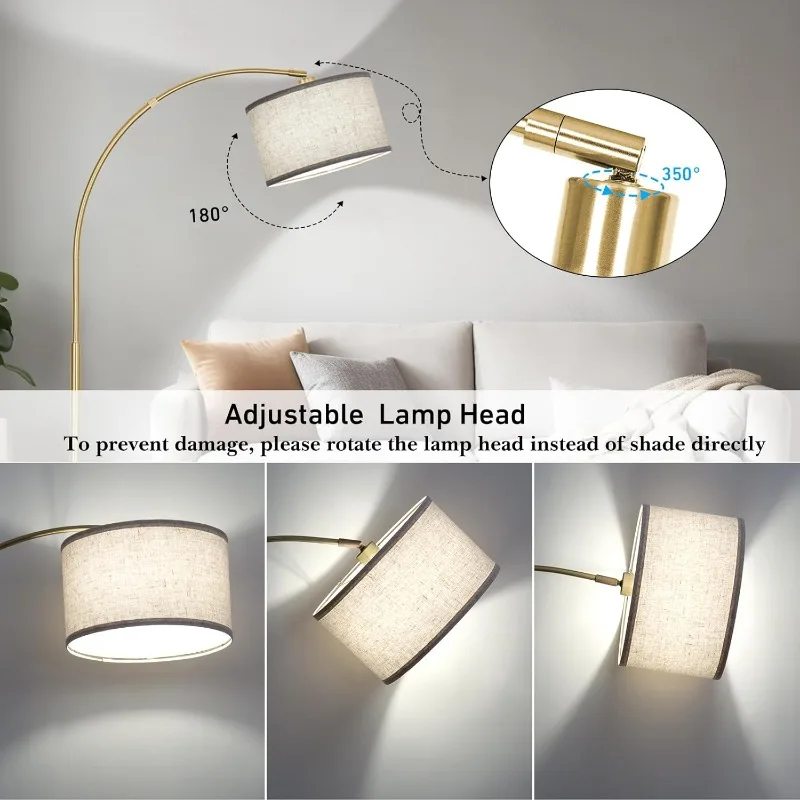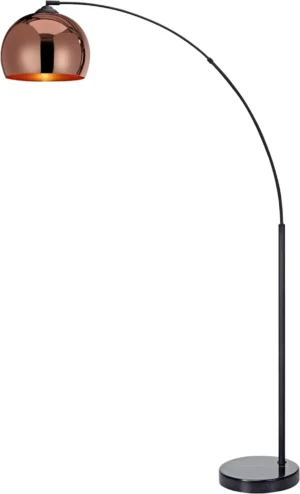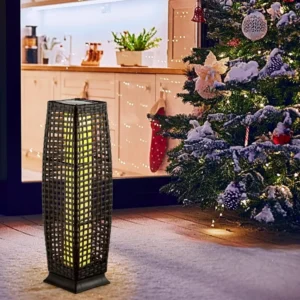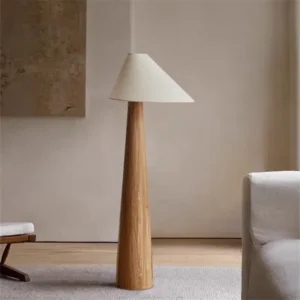Introduction: The Timeless Appeal of Wood Arc Lamps
Wood arc floor lamps stand as distinctive lighting fixtures characterized by their graceful curved stems, natural wooden elements, and statement-making presence. These elegant pieces have gained remarkable popularity in contemporary interior design, offering a perfect blend of form and function that few other lighting options can match. Their curved silhouette creates visual interest while providing practical overhead lighting without the need for ceiling installation.
What makes wood arc lamps particularly appealing is their impressive versatility across different design aesthetics. From the clean lines of Scandinavian interiors to the warm richness of mid-century modern spaces, these lamps have evolved from their classic origins to embrace numerous modern interpretations. Today’s designs range from minimalist wooden arcs with simple drum shades to elaborate creations with intricate details that serve as artistic focal points. The growing presence of these perfect arc floor lamp choices in high-end design magazines and social media platforms confirms their status as both timeless classics and contemporary must-haves.
Why Wood Arc Lamps Are a Design Statement in Modern Interiors
Natural Warmth and Organic Appeal
In an era dominated by technology and synthetic materials, wood arc lamps bring a refreshing element of nature indoors. The organic quality of wood creates instant warmth and tactile appeal that softens even the most contemporary spaces. Whether featuring light ash, rich walnut, or golden oak, these lamps introduce natural variation and character through unique grain patterns that can’t be replicated by manufactured materials. This connection to nature satisfies our innate biophilic desires, making spaces feel more welcoming and psychologically comfortable.
Sculptural Form as Functional Art
Beyond their practical purpose, wood arc lamps serve as sculptural elements that transform ordinary rooms into curated spaces. Their dramatic curved forms create visual interest even when not illuminated, functioning as three-dimensional art pieces that draw the eye upward and create a sense of dynamic movement. Many interior designers use these lamps as statement pieces that anchor a room’s design, proving that functional items can also be beautiful artistic expressions.
Versatility in Ambient and Task Lighting
The distinctive arching design of these lamps provides remarkable lighting versatility. Their height and reach allow light to be directed precisely where needed, making them excellent for task lighting over reading chairs or dining tables. Simultaneously, they create a soft ambient glow that enhances the overall atmosphere of a space. This dual functionality makes wood arc floor lamps particularly valuable in multipurpose rooms where lighting needs vary throughout the day.
Sustainability and Craftsmanship
In today’s eco-conscious market, the appeal of natural materials and artisanal quality cannot be overstated. Quality wood arc lamps represent sustainable choices when crafted from responsibly sourced timber, reflecting a growing consumer preference for environmentally mindful products. These pieces often showcase exceptional craftsmanship—from precisely joined wood components to hand-finished surfaces—providing an antidote to mass-produced, disposable furnishings. The investment in well-made wooden lighting speaks to a renewed appreciation for pieces designed to last for generations.
Top Decor Trends Embracing Wood Arc Lamps
Wood arc lamps have demonstrated remarkable adaptability across diverse interior design aesthetics, allowing them to enhance virtually any well-considered space. What makes these fixtures particularly interesting is how they’ve been reimagined to suit different stylistic approaches while maintaining their essential curved form and warm wooden elements.
The following design trends represent distinct ways designers and homeowners incorporate these versatile lighting fixtures, from the clean simplicity of Scandinavian design to the rustic warmth of modern farmhouse interiors. Each style interprets the wood arc lamp differently, emphasizing various wood types, finishes, and complementary elements that warm up rooms with wood arc lamps in unique and inspiring ways.
Scandinavian Serenity: Lightness and Function
Scandinavian design embraces a philosophy of clean simplicity, functionality, and connection to nature—making it a perfect match for wood arc lamps. In these light-filled spaces, the emphasis is on creating a sense of hygge (the Danish concept of coziness and contentment) through thoughtful, minimalist choices that maximize both beauty and utility.
Wood arc lamps in Scandinavian interiors typically feature:
– Light wood tones such as birch, ash, and bleached oak that enhance the airy quality
– Simple, clean-lined forms without excessive ornamentation
– Neutral-colored drum shades in natural fabrics like linen or cotton
– Slender proportions that maintain visual lightness
These lamps complement other Scandinavian elements beautifully—pairing harmoniously with light wood furniture, sheepskin throws, and a predominantly white and gray color palette accented with subtle blues and greens. The overall effect creates spaces that feel both calming and uplifting, where the wood arc lamp provides both functional illumination and organic sculptural appeal.
Japandi Harmony: Blending East and West
Japandi design—a fusion of Japanese and Scandinavian aesthetics—has emerged as one of the most sophisticated and balanced interior styles. This hybrid approach combines Scandinavian functionality with Japanese minimalism and craftsmanship, creating spaces that feel both serene and warmly inviting.
In Japandi interiors, wood arc lamps typically showcase:
– Natural wood finishes that highlight the material’s inherent beauty
– A balance between form and function with nothing superfluous
– Wabi-sabi appreciation for imperfection and natural aging
– Paper or woven shades that diffuse light softly
– Woods with prominent grain patterns like oak or walnut with natural finishes
These lamps enhance the Japandi aesthetic when paired with low-profile furniture, natural textiles, and a muted color palette featuring earthy neutrals like sand, clay, and charcoal. The emphasis remains on quality over quantity, creating uncluttered spaces where each piece has purpose and beauty. The subtle curves of a well-designed minimalist arc floor lamp can become a focal point that anchors the entire room while exemplifying Japandi principles.
Mid-Century Modern Revival: Classic Curves and Warm Tones
The enduring popularity of mid-century modern design stems from its timeless blend of organic forms, clean lines, and functional elegance. Original arc lamps were, in fact, mid-century innovations, making today’s wooden versions natural heirs to this rich design heritage.
Mid-century-inspired wood arc lamps typically feature:
– Warm medium to dark woods, particularly walnut and teak
– Gentle organic curves balanced with geometric elements
– Brass or gold-toned metal accents for added warmth
– Tapered legs or tripod bases with distinctive angles
– Drum or cone-shaped shades in textured fabrics
These statement pieces pair beautifully with iconic mid-century furniture like low-slung sofas, Eames lounge chairs, and teak sideboards. The color palette typically embraces rich hues like mustard yellow, olive green, burnt orange, and deep blue, creating spaces with visual warmth and nostalgic appeal. A well-chosen mid-century arc floor lamp can serve as an authentic-looking centerpiece that anchors the entire aesthetic.
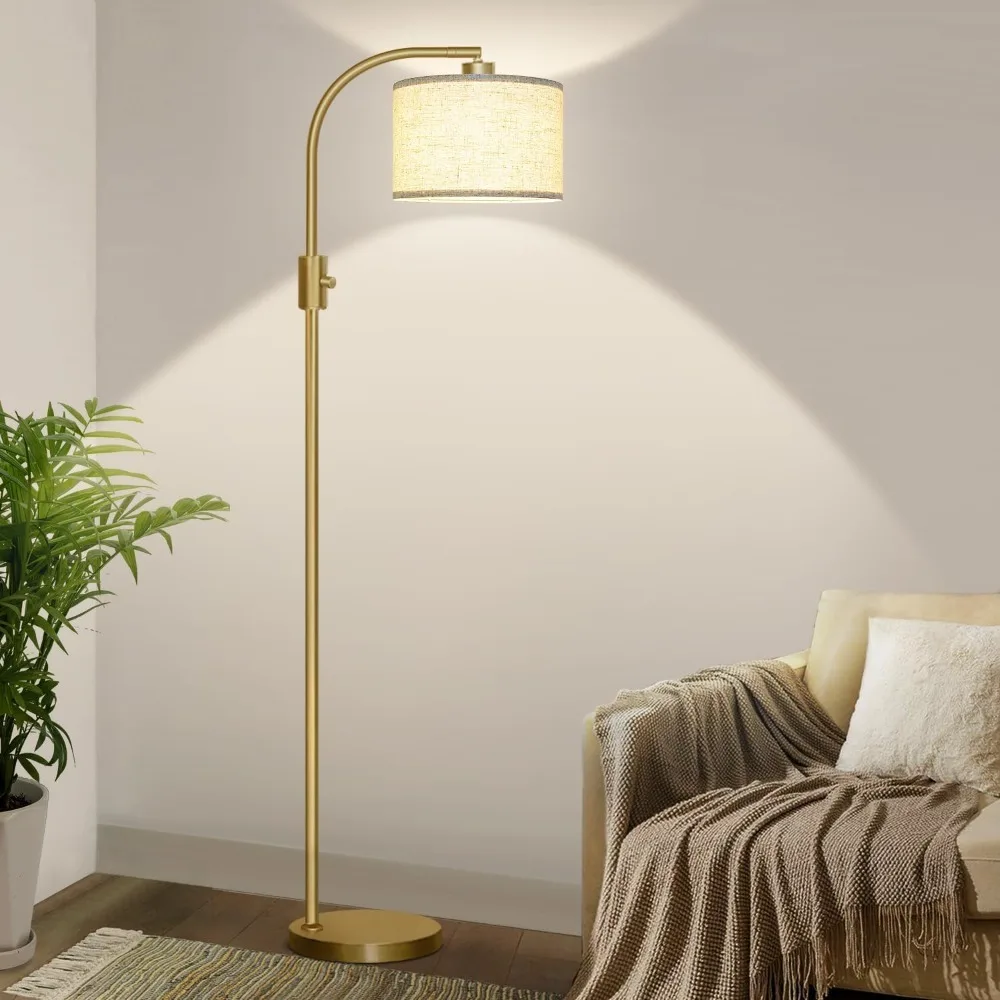
Bohemian Chic: Eclectic and Relaxed Spaces
Bohemian style celebrates creativity, cultural diversity, and personalized expression through layered textures and eclectic combinations. In these free-spirited spaces, wood arc lamps contribute organic form and natural warmth while complementing the style’s characteristic abundance.
Bohemian-inspired wood arc lamps often showcase:
– Natural or distressed wood finishes with visible character and patina
– Unique wood grains and variations that highlight authenticity
– Rattan, wicker, or macramé shade elements for textural interest
– Asymmetrical or one-of-a-kind forms that suggest artistic creation
– Mixed material elements that create visual intrigue
These distinctive lamps harmonize with signature Bohemian elements like low-slung seating, vintage textiles, global patterns, and abundant plants. The color scheme typically embraces rich jewel tones, earthy neutrals, and metallics for a collected-over-time aesthetic. The curve of a rattan arc floor lamp creates dynamic movement within these layered spaces while providing a grounding natural element.
Minimalist Elegance: Simplicity and Purpose
Contemporary minimalism moves beyond stark simplicity to embrace thoughtful restraint and quality materials. In these carefully curated spaces, wood arc lamps offer sculptural interest without visual clutter, embodying the minimalist principle that every element should serve both function and aesthetic purpose.
Minimalist wood arc lamps typically feature:
– Clean, precise lines with intentional curves
– Either very light or very dark wood tones with smooth, uniform finishes
– Integrated LED lighting that eliminates visual distraction
– Hidden mechanisms that maintain visual purity
– Simple shade forms or shade-free designs that emphasize structure
These refined fixtures complement the minimalist aesthetic when paired with architectural furniture pieces, monochromatic color schemes, and selected materials like glass, stone, and metal. The emphasis remains on negative space and visual breathing room, allowing the wood arc lamp to make a quiet yet powerful statement through its essential form rather than decorative embellishment.
Modern Farmhouse: Rustic Meets Contemporary
Modern farmhouse style blends rustic warmth with contemporary simplicity, creating spaces that feel both timeless and fresh. This popular aesthetic balances weathered elements with clean lines, making it perfectly suited for wood arc lamps that combine natural materials with modern forms.
In modern farmhouse interiors, wood arc lamps often feature:
– Distressed or reclaimed woods with character and history
– Whitewashed or weathered finishes that suggest age and patina
– Industrial elements like visible joints or metal accents
– Linen or cotton shades in neutral tones
– Substantial proportions that create presence
These statement pieces complement signature farmhouse elements like shiplap walls, industrial metals, and comfortable upholstery. The color scheme typically embraces whites, blacks, and warm neutrals with occasional pops of navy or sage green. The arc’s curve creates visual interest among the predominantly straight lines of farmhouse architecture, while the wood elements reinforce the style’s connection to natural materials and craftsmanship.
Choosing Your Ideal Wood Arc Lamp: A Comprehensive Guide
Selecting the perfect wood arc lamp requires balancing aesthetic preferences with practical considerations. While style certainly matters, equally important are factors like appropriate sizing, light quality, and material durability—elements that ensure your lamp will function effectively while looking beautiful for years to come.
Finding the ideal match for your space involves examining the lamp’s components individually—from wood species and finish to shade material and base design—while also considering how these elements work together as a cohesive whole. The following sections explore these critical selection factors in detail, helping you identify what to look for in an arc floor lamp that will enhance your specific space and meet your unique needs.
Understanding Wood Species and Finishes
The wood species and finish of your arc lamp significantly impact its appearance, durability, and how it integrates with your existing decor. Common woods used in quality arc lamps include:
Oak: Features prominent grain patterns and excellent durability. Light oak brings casual warmth, while darker oak stains offer traditional elegance.
Walnut: Prized for its rich, chocolate-brown tones and straight grain with occasional swirls. Offers natural sophistication and pairs beautifully with mid-century and contemporary designs.
Ash: Lighter in color with prominent grain similar to oak, but typically straighter. Highly flexible yet durable, making it excellent for bent forms.
Birch: Very light in color with subtle grain, providing a clean Scandinavian aesthetic. Takes stain well if a different finish is desired.
Teak: Golden-brown wood with natural oils that increase durability. Develops a silver-gray patina over time if left untreated.
Finishes range from natural clear coats that highlight the wood’s inherent color and grain to stains that alter the color while still revealing grain patterns. Painted finishes conceal the grain entirely but can coordinate with specific color schemes. Consider how the finish affects not only appearance but also maintenance—some require more regular care to maintain their beauty over time.
Shade Materials and Light Diffusion
The shade material dramatically impacts both the lamp’s appearance and the quality of light it produces:
Fabric Shades: Create soft, diffused light ideal for ambient illumination. Linen provides textural interest and moderate light diffusion, while cotton offers a crisp, clean look with even diffusion. Polyester blends provide durability and consistent light filtering.
Paper/Rice Paper: Often found in Japandi designs, offering gentle diffusion that creates a warm glow. While beautiful, these require careful handling and may need replacement over time.
Metal Shades: Direct light downward for focused task lighting. Create dramatic contrast with wooden elements and suit industrial or modern farmhouse styles.
Woven Natural Materials: Including rattan, seagrass, and wicker. Create interesting shadow patterns while adding textural dimension. Perfect for bohemian and coastal interiors but may gather dust over time.
Each material creates a distinct lighting effect and aesthetic impression. Consider not only how the shade looks when the lamp is off but also how it transforms when illuminated—some materials become nearly transparent, while others remain opaque, directing light primarily up and down.
Base Design and Stability Considerations
The base of a wood arc lamp provides both stability and style. Common options include:
Marble Bases: Offer exceptional stability through weight rather than size, creating a refined look with minimal footprint. The natural variations in marble provide visual interest that complements wood elements.
Metal Weighted Bases: Provide solid anchoring with sleek contemporary appeal. Often feature slim profiles that work well in tight spaces.
Wood Block Bases: Create visual continuity with the arc but may require more substantial size for adequate stability.
Tripod Designs: Distribute weight across three points for excellent stability while creating interesting geometric forms. Particularly well-suited to mid-century modern aesthetics.
When evaluating bases, consider both stability and floor protection. Quality lamps include protective padding to prevent scratches on hard surfaces. The visual weight of the base should balance with the arc’s sweep—too small a base can make a lamp appear unbalanced, while an overly large base might overwhelm delicate arcs. Our collection of marble base arc floor lamps offers excellent stability with sophisticated style.

Size, Reach, and Height Considerations
Selecting the appropriate size for your wood arc lamp ensures it both fits your space properly and provides light where needed. Consider these factors when evaluating dimensions:
Overall Height: Should be proportional to your ceiling height—taller ceilings accommodate taller lamps. Generally, the lamp’s highest point should sit below eye level when you’re standing.
Arc Reach: Determines how far the light extends from the base. For reading areas, ensure the light reaches over seating at an appropriate height and angle. For dining areas, make sure it centers properly over the table.
Base Dimensions: Consider your available floor space and traffic patterns. Even compact bases need adequate clearance to prevent tripping hazards.
Many quality wood arc lamps offer adjustable features that enhance their versatility, including height adjustability, rotating heads, or adjustable arcs. These features allow customization to different activities and times of day, making them especially valuable in multipurpose spaces. Finding the perfect arc floor lamp height significantly impacts both functionality and visual harmony within your space.
Lighting Functionality and Smart Features
The lighting capabilities of your wood arc lamp determine how effectively it serves your practical needs while creating your desired ambiance:
Brightness and Direction: Consider the lamp’s primary purpose—task lighting requires more focused, brighter illumination, while ambient lighting can be softer and more diffused. Look for lumen ratings (brightness measurement) appropriate to your needs.
Dimming Capabilities: Dimmable fixtures offer flexibility for different activities and times of day. Some feature step dimming (multiple set levels), while others offer continuous dimming for precise control.
Bulb Compatibility: Check which bulb types the lamp accommodates. LED options provide energy efficiency and longevity, while some lamps accommodate smart bulbs that enable color temperature adjustments and integration with home automation systems.
Color Temperature: Measured in Kelvins (K), this affects the light’s perceived warmth or coolness. Lower values (2700-3000K) produce warmer, yellowish light ideal for relaxing spaces, while higher values (4000K+) create cooler, bluer light better for task-focused areas.
Consider how your lighting needs might change throughout the day or for different activities. Lamps with multiple adjustment options and compatibility with various bulb types offer the greatest versatility for evolving needs.
Strategic Placement and Integration Ideas
The placement of your wood arc lamp significantly impacts both its visual impact and functional effectiveness. Strategic positioning can transform a lamp from merely a light source to a defining element that anchors your space and enhances its overall design. The lamp’s dramatic curve creates a visual line that draws the eye, making placement particularly important for establishing focal points and creating visual flow.
When determining ideal placement, consider the lamp’s dual roles: providing practical illumination and creating aesthetic impact. The perfect position achieves both while maintaining comfortable traffic flow and proper proportion with surrounding furniture. The height and reach of the arc should relate logically to the elements beneath it, whether illuminating a seating arrangement, highlighting architectural features, or defining activity zones within an open floor plan.
Enhancing the Living Room
The living room offers numerous strategic placement opportunities for wood arc lamps to both illuminate activities and enhance the overall design:
Behind Sofas: Positioning an arc lamp behind a sofa creates a graceful curve that frames the seating area while providing perfect overhead light for reading or conversation. Ideally, the shade should hang 55-65 inches from the floor and center over the area you wish to illuminate.
Over Side Seating: Arc lamps excel at transforming occasional chairs into dedicated reading nooks. Position the base beside the chair and adjust the arc so the light falls directly over the seat at approximately shoulder height when seated.
Corner Activation: Placing an arc lamp in an otherwise empty corner adds vertical interest and illumination without consuming valuable floor space. This placement draws attention to architectural features while expanding the room’s perceived dimensions.
Conversation Area Definition: In open-concept spaces, an arc lamp can visually define a conversation area, creating an intimate zone within a larger room. Position the lamp so its curve embraces the seating arrangement, creating a visual boundary.
The versatility of best arc lamps for living rooms allows them to adapt to various furniture arrangements. For optimal balance, ensure the base is positioned where it won’t obstruct movement but still allows the light to reach its intended target. The lamp’s curve should flow with the room’s circulation patterns rather than interrupting them.
Creating Ambiance in the Bedroom
Wood arc lamps offer creative alternatives to traditional bedroom lighting, combining functional illumination with sculptural beauty:
Bedside Alternative: Replacing conventional table lamps with an arc floor lamp frees up nightstand space while providing adjustable reading light. Position the base behind the nightstand with the arc extending over the bed corner, or place it beside the nightstand with the arc reaching over.
Reading Corner Illumination: Create a dedicated reading retreat by positioning an arc lamp over a comfortable bedroom chair. The light should fall at book level when seated, typically 38-44 inches from the floor.
Ambient Lighting Source: For general illumination, place the arc lamp in a corner where its light can reflect off walls, creating a soft, diffused glow throughout the space. This indirect lighting creates a more relaxing atmosphere than harsh overhead fixtures.
In smaller bedrooms, look for lamps with compact bases and adjustable arcs that can be repositioned as needed. Consider models with dimming capabilities to transition from bright task lighting to subtle ambient illumination for evening relaxation.
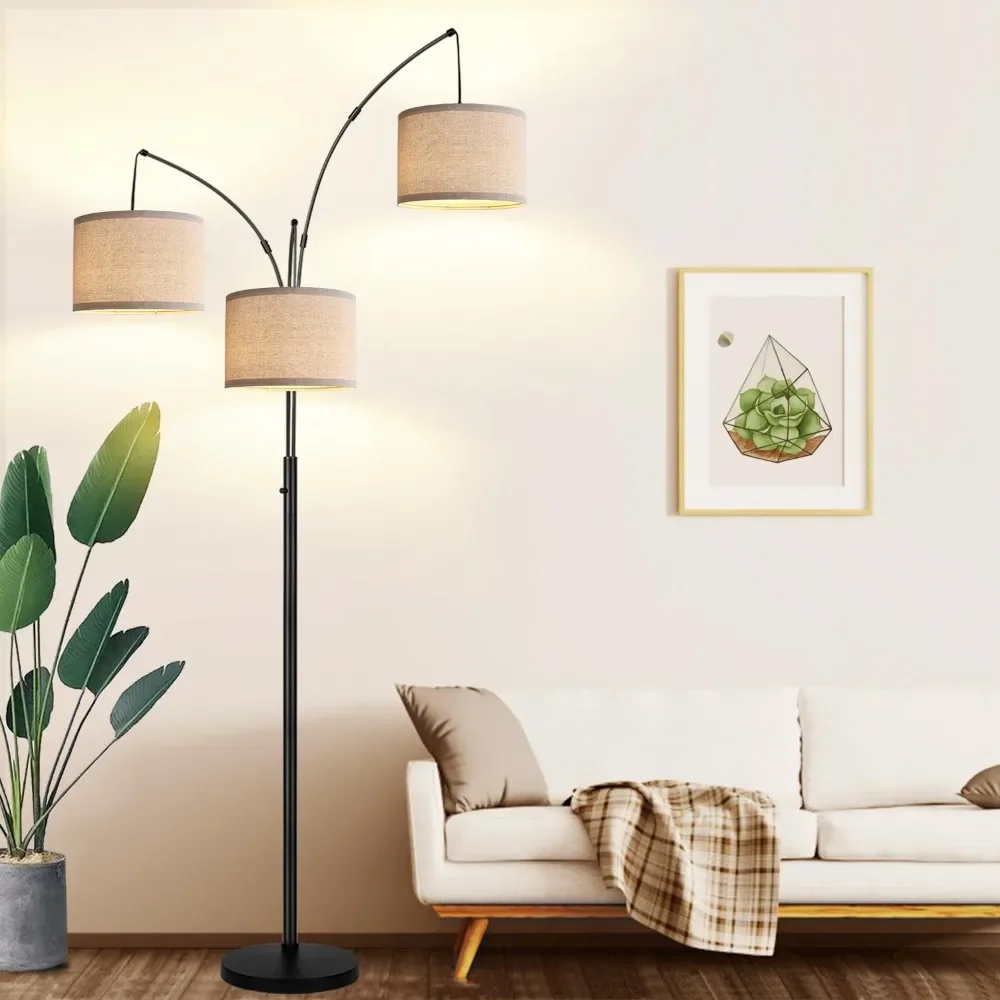
Elevating the Dining Area
Wood arc lamps offer a refreshing alternative to traditional pendant lighting over dining tables:
Centered Illumination: Position an arc lamp with its base outside the dining area but with the arc extending to center the shade directly over the table. For standard height dining tables, the bottom of the shade should hang approximately 30-36 inches above the table surface.
Off-Center Interest: For a more dynamic approach, position the lamp to illuminate one end or side of the table, creating an asymmetrical design statement while still providing functional lighting.
Buffet or Sideboard Highlighting: Place the lamp to illuminate a dining room sideboard or buffet, drawing attention to decorative elements while providing ambient light for the entire dining space.
When selecting an arc lamp for dining areas, consider models with longer reaches that can extend fully over tables without placing the base where it might interfere with seating or traffic flow. The lamp should provide enough light for comfortable dining while creating an intimate atmosphere—dimmable options are particularly valuable in this setting.
Contemporary Arc Floor Lamp, Large Arc Floor Lamp, Marble Base Arc Floor Lamp
$224.94 Select options This product has multiple variants. The options may be chosen on the product pageMid-Century Arc Floor Lamp, Wood Arc Floor Lamp
$230.86 Select options This product has multiple variants. The options may be chosen on the product pageLED Arc Floor Lamp, Rattan Arc Floor Lamp
$313.58 Select options This product has multiple variants. The options may be chosen on the product pageVintage Arc Floor Lamp, Wood Arc Floor Lamp
Price range: $603.87 through $1,346.09 Select options This product has multiple variants. The options may be chosen on the product page- $1,003.85 Select options This product has multiple variants. The options may be chosen on the product page
Minimalist Arc Floor Lamp, Wood Arc Floor Lamp
Price range: $366.32 through $1,008.61 Select options This product has multiple variants. The options may be chosen on the product page
Stylizing the Home Office
Wood arc lamps bring both functional task lighting and design sophistication to home office spaces:
Desk Illumination: Position the lamp to provide light over your primary work area without creating screen glare. The light source should come from your non-dominant side to prevent shadows when writing.
Conference/Meeting Zone: In offices that include small meeting areas, an arc lamp can define and illuminate this zone while adding visual interest. Position it to provide even light across the conversation area.
Background Enhancement for Video Calls: Consider how the lamp appears in the background of video conferences. Well-placed arc lamps create depth and visual interest on camera while providing flattering indirect lighting.
For home offices, select lamps with adjustable features that can adapt to different tasks throughout the day. Consider models with color temperature options that support focus during work hours but can shift to warmer tones for evening use.
Curating a Cohesive Look: Complementary Elements
While a wood arc lamp makes a striking statement on its own, its full potential emerges when thoughtfully integrated into a complete design scheme. Creating a cohesive environment involves viewing the lamp as part of an interconnected whole where each element enhances and supports the others. This holistic approach ensures the lamp feels intentional rather than isolated—becoming an integral part of your space’s story.
The key to successful integration lies in establishing meaningful connections between your wood arc lamp and other elements in the room. These connections might be material echoes (repeating similar wood tones), formal relationships (complementary curves or lines), or functional partnerships (creating activity zones with furniture groupings). The following sections explore specific categories of complementary elements that enhance the impact of wood arc lamps while creating visually harmonious spaces.
Furniture Pairings by Style
Different design aesthetics call for specific furniture pairings that complement wood arc lamps:
Scandinavian: Light wood furniture with clean lines and minimal ornamentation. Look for pieces with tapered legs and organic shapes in birch, ash, or light oak that echo the lamp’s wood tone. Low-profile sofas and armchairs with textural fabrics create balanced compositions.
Japandi: Platform beds, low sofas, and simple dining furniture in natural wood finishes. Seek pieces that emphasize horizontal lines to contrast with the lamp’s verticality. Black accents create dramatic contrast with lighter wood tones.
Mid-Century Modern: Furniture with distinctive silhouettes like wishbone chairs, platform sofas with tapered legs, and case goods with sculptural hardware. Match or intentionally contrast wood tones—walnut with walnut for harmony or walnut with teak for subtle variation.
Bohemian: Relaxed, eclectic furniture with natural materials and handcrafted elements. Rattan chairs, low-slung seating, vintage wood pieces, and globally-inspired tables create collected authenticity. Mix rather than match wood tones for an evolved-over-time look.
Minimalist: Architectural furniture with clean lines and minimal visual weight. Consider pieces that float above the floor or feature precise geometric forms. Either match the lamp’s wood tone exactly or create deliberate contrast with different materials.
Modern Farmhouse: Substantial pieces with traditional forms updated for contemporary living. Look for farmhouse tables, slipcovered sofas, and storage pieces with shiplap or beadboard details. Distressed or reclaimed wood furnishings echo the character often found in farmhouse-style arc lamps.
Harmonious Color Palettes
Creating effective color schemes that enhance wood arc lamps requires understanding how different wood tones interact with various colors:
Light Woods (birch, ash, maple): Pair with cool blues, greens, and grays for a fresh Scandinavian look. For warmth, combine with soft terracotta, amber, or coral accents against a neutral backdrop.
Medium Woods (oak, cherry): Versatile companions to most color schemes. Cool gray-blues create sophisticated contrast, while warm rusts and mustards enhance the wood’s inherent warmth. Green tones particularly complement oak’s natural undertones.
Dark Woods (walnut, mahogany): Pair with jewel tones like emerald, sapphire, or amethyst for rich, luxurious schemes. Alternatively, create dramatic contrast with crisp whites and soft creams. Warm metallics like brass and gold enhance dark wood’s sophistication.
Weathered/Distressed Woods: Complement with muted, dusty versions of colors—sage instead of emerald, navy instead of cobalt, terracotta instead of orange. These subdued tones honor the aged quality of the wood.
Using color to create visual connections between your lamp and other elements helps unify the space. Consider pulling a color from your rug or artwork that harmonizes with the wood tone, then repeat this color in smaller accents throughout the room.
Textiles and Textures
Thoughtful textile selections soften the structural presence of wood arc lamps while creating cohesive design through texture and pattern:
Area Rugs: Anchor your lamp and furniture grouping with an appropriately sized rug that incorporates colors harmonious with the wood tone. For light woods, consider rugs with subtle patterns and texture. For darker woods, bolder patterns create balanced contrast.
Upholstery: Select fabrics that complement your lamp’s finish—natural linens and cottons with lighter woods, richer velvets and woven textures with darker woods. Consider introducing subtle patterns that echo the lamp’s curve.
Window Treatments: Create visual harmony by selecting treatments that relate to your lamp’s shade material. Linen shades pair beautifully with linen drapes, while woven shades connect to natural fiber blinds or textured curtains.
Throws and Pillows: Use these smaller textile elements to build color bridges between your wood arc lamp and larger furniture pieces. Introduce textures that contrast with the smooth finish of the wood—chunky knits, nubby weaves, or plush velvets.
Layering different textiles adds dimensional interest while softening the more structured elements in your space. The juxtaposition of hard and soft creates visual and tactile richness that makes rooms feel thoughtfully composed and inviting.
Greenery and Natural Elements
Plants and natural accessories enhance the organic quality of wood arc lamps while adding vitality to interior spaces:
Large Floor Plants: Position substantial plants like fiddle leaf figs, olive trees, or bird of paradise near wood arc lamps to create height variation and reinforce natural elements. The lamp’s curve can visually “embrace” the plant, creating a harmonious composition.
Tabletop Plants: Smaller plants on nearby surfaces create connection points with the lamp. Consider trailing plants for vertical interest or sculptural varieties like snake plants that echo the lamp’s linear qualities.
Natural Materials: Incorporate additional natural elements like stone bowls, wooden trays, or ceramic vessels that complement the lamp’s organic character. These elements create material dialogue throughout the space.
Dried Elements: Pampas grass, dried branches, or preserved botanicals add texture and natural interest while requiring minimal maintenance. Their neutral colors complement most wood tones beautifully.
For cohesive design, consider the growth habits of plants—those with arching or cascading forms naturally complement the curve of arc lamps, while more upright varieties create interesting counterpoints.
Art and Wall Decor
Thoughtful art selection creates meaningful relationships between your wood arc lamp and wall decor:
Scale Consideration: Balance the substantial presence of arc lamps with appropriately scaled artwork. Consider larger single pieces or curated gallery arrangements with visual weight similar to the lamp.
Compositional Relationships: Position art so the lamp’s curve creates a visual connection or framing effect. The arc can lead the eye toward a focal artwork or create a sense of balance with wall compositions.
Thematic Connections: Consider artwork with organic forms, natural themes, or architectural elements that relate conceptually to the lamp’s wooden material or curved form.
Color Bridges: Use artwork that incorporates colors found in both the lamp’s wood tone and other furnishings to create cohesive color flow throughout the space.
The relationship between three-dimensional lighting elements and two-dimensional wall decor creates visual conversation that enhances both. The lamp brings depth and dimension while the artwork contributes color, pattern, and conceptual interest.
Expert Tips for Optimal Lighting and Maintenance
Maximizing both the aesthetic appeal and functional performance of your wood arc lamp requires attention to lighting strategy and proper maintenance. These professional insights will help you create ideal illumination while preserving your lamp’s beauty for years to come.
Layering Light Sources
Wood arc lamps work best as part of a comprehensive lighting plan that includes multiple sources:
– Pair arc lamps with wall sconces or table lamps to eliminate harsh shadows and create even illumination
– Use arc lamps for directed task lighting while incorporating ambient sources for general illumination
– Consider how natural light interacts with your lamp throughout the day, adjusting other sources accordingly
– Add accent lighting to highlight architectural features or artwork that complements the lamp
Selecting the Right Bulbs
The bulb you choose dramatically impacts both light quality and energy efficiency:
– For reading or task areas, look for bulbs providing 800-1100 lumens
– For ambient lighting, 400-800 lumens creates a warm glow without overwhelming the space
– Consider color temperature based on the room’s purpose—warmer tones (2700-3000K) for living spaces and bedrooms; cooler tones (3500-4000K) for offices or activity areas
– Dimmable LED bulbs offer maximum flexibility, allowing adjustment for different times and activities
Wood Care Essentials
Proper maintenance preserves the beauty of wooden components:
– Dust regularly with a soft, dry cloth to prevent buildup that can dull the finish
– For deeper cleaning, use products specifically formulated for finished wood
– Avoid placement in direct sunlight, which can cause uneven fading over time
– Maintain consistent humidity levels to prevent wood from cracking or warping
– Apply furniture wax or polish designed for your specific finish type once or twice yearly
Shade Maintenance
Different shade materials require specific care approaches:
– Fabric shades benefit from regular vacuuming with a brush attachment to remove dust
– Paper or rice paper shades should be gently dusted with a soft cloth or feather duster
– Remove stains on fabric shades using dry cleaning solvents applied with a clean white cloth
– Woven natural materials may be carefully vacuumed and occasionally wiped with a slightly damp cloth
With proper care and choosing the perfect arc floor lamp for your needs, these statement pieces can remain beautiful and functional for decades, becoming cherished elements in your evolving interior design.
Can Wood Arc Lamps Work in Small Spaces?
While wood arc lamps make dramatic statements, they can indeed work beautifully in smaller spaces when selected and positioned thoughtfully. Their ability to provide overhead lighting without ceiling installation makes them particularly valuable in apartments or rental properties where permanent fixtures aren’t an option.
For compact environments, look for models with space-saving features like:
– Smaller diameter bases that require minimal floor space
– Shorter arc reaches that still provide directed light without overwhelming the room
– Adjustable arcs that can be positioned differently as needs change
– Compact shade dimensions that maintain proportion with smaller furniture
Strategic placement is especially crucial in limited square footage. Consider positioning arc lamps in corners where their bases occupy otherwise unused space while their arcs extend over functional areas. Another effective approach is placing them behind or beside sofas where their bases are partially concealed yet their light reaches where needed.
The visual weight of a wood arc lamp can actually make small spaces feel more intentionally designed and architecturally interesting. Their curves create movement that guides the eye through the space, while their elevated light source draws attention upward, enhancing the perception of height and openness.
Are Wood Arc Lamps Worth the Investment?
Wood arc lamps typically represent a higher price point than standard floor lamps, raising the question of their value proposition. When evaluating this investment, consider factors beyond initial cost—particularly longevity, versatility, and design impact.
Quality wood arc lamps offer exceptional durability when compared to less expensive lighting options. Their solid wood construction, weighted bases, and superior finishing resist wear and damage that might render cheaper alternatives unusable within a few years. Higher-end models often feature replaceable parts, meaning a damaged shade or worn switch doesn’t necessitate replacing the entire fixture.
The design versatility of wood arc lamps also enhances their long-term value. Unlike trend-driven lighting that quickly appears dated, well-designed wood arc lamps have proven their staying power across decades. Their ability to complement various design aesthetics means they can transition through multiple home styles and locations as your tastes evolve. The timeless appeal of authentic mid-century arc lamps demonstrates how quality lighting transcends fleeting trends.
Beyond practical considerations, the investment value includes the daily aesthetic enjoyment and functionality these fixtures provide. As both illumination sources and sculptural elements, they deliver dual benefits that justify their cost for many discerning homeowners. Their ability to transform ordinary rooms into distinctive spaces offers lasting satisfaction that purely utilitarian lighting cannot match.
How Do Wood Arc Lamps Compare to Metal Alternatives?
When deciding between wood and metal arc lamps, understanding their distinctive characteristics helps determine which better suits your specific needs and aesthetic preferences.
Wood arc lamps bring natural warmth and organic character that metal versions typically cannot provide. The wood grain creates visual interest and tactile appeal that connects to other natural elements in your space. These lamps often feel more inviting and less industrial than their metal counterparts, making them particularly well-suited to spaces where warmth and comfort are priorities.
Metal arc lamps, conversely, offer sleeker, more contemporary profiles that may better complement very modern interiors. Their reflective surfaces can brighten spaces by bouncing light, while their typically thinner proportions may appear less visually substantial in large rooms. Metal also allows for more extreme curves and cantilevers that might not be structurally possible with wood.
From a practical perspective, wood lamps often provide greater stability through their substantial construction and weighted bases. They typically age gracefully, developing character over time rather than showing wear as obviously as metal surfaces might. Metal lamps, however, generally offer more adjustment options and may feature more technical innovations in terms of movement and positioning.
Some of the most versatile designs incorporate both materials—wooden arcs with metal accents or bases that combine the warmth of wood with the precision and reflectivity of metal. These hybrid designs offer the best of both worlds, bringing organic elements together with contemporary detailing for balanced, sophisticated lighting solutions.

